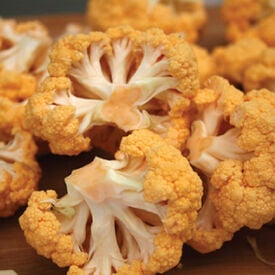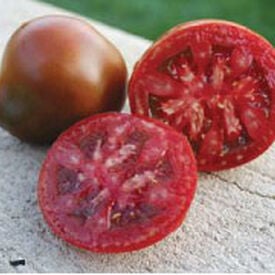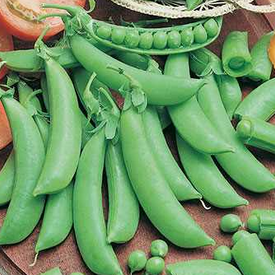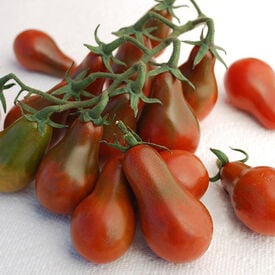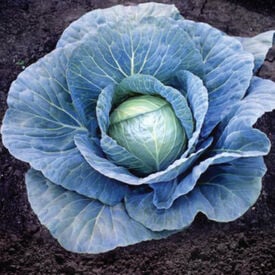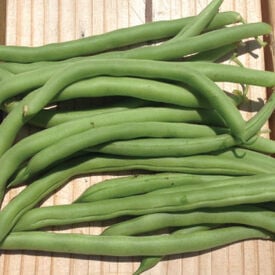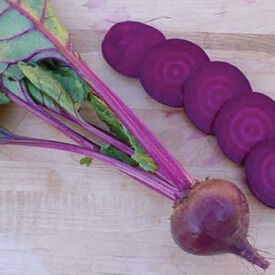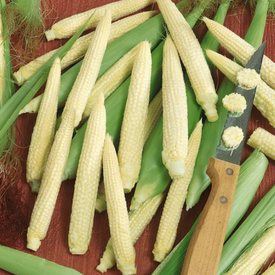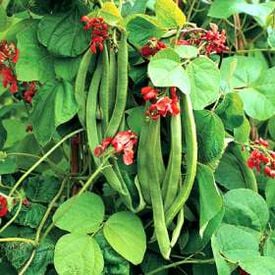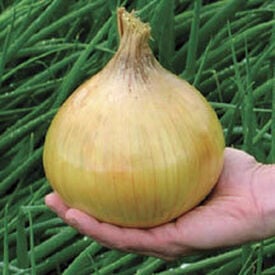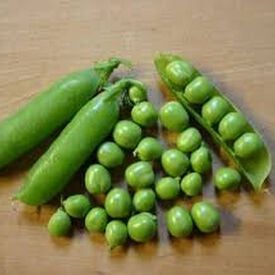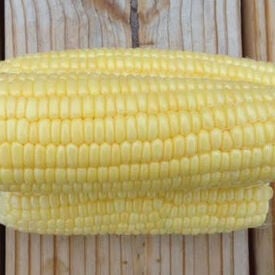The Cheddar cauliflower lives up to its name with its awesome cheddar color and great flavor! This cauliflower is a novelty, orange curd that is high in beta-carotene. A mid-size plant, domed head, and is very productive in the fall. Fun to watch grow and eat!
A deep burgundy flesh with rich flavor! Black Truffel is rich in both sugars and acid, which helps create a sweet, strong, complex flavor that is hard to beat. The 6-8 oz. pear-shaped fruits are just large enough for slicing into salads. Once you try the Black Truffel you will grow it for years in your garden!
Buttercrunch lettuce seeds produce a popular variety known for its crisp, tender leaves and sweet, buttery flavor. This heirloom variety features thick, light green leaves that form a loose, rosette shape, making it visually appealing in the garden and on the plate. Buttercrunch lettuce is known for its ability to tolerate heat better than many other lettuces, which allows for extended growing seasons. The leaves are slightly wavy and have a delicate texture, making them perfect for salads, sandwiches, and wraps. They also hold up well in dressings, adding a delightful crunch. When grown from seed, Buttercrunch lettuce typically germinates quickly, with seedlings developing into lush heads in a relatively short time. It thrives in cooler weather, making it an excellent choice for spring and fall gardens. Overall, Buttercrunch lettuce seeds offer a reliable and delicious option for home gardeners seeking to enjoy fresh, homegrown greens!
The Old Fashioned Mustard Green is a real Southern treat! This green is a favorite that can be eaten fresh or cooked, but is best enjoyed either steamed or sautéed in our opinion! The Old Fashioned Mustard is easy to grow and care for, making it a great addition to any garden.
Cascadia Pea is a major garden staple for its heavy yields of great tasting and crispy pea pods. Enjoy bucketloads of large, crisp pods with small, sugary peas! The 3' tall vines should be supported on a trellis or fence. Cascadia's multiple disease resistances allow for spring and late season plantings.
The Chocolate Pear is a super productive variety that produces little chocolate-brown colored pear tomatoes that are the perfect size for snacking! This pear shaped variety has a rich tomato flavor that is excellent for adding to salads, pastas or even just to eat by the handful! The Chocolate Pear is a nice tomato for market growing and is perfect to mix with other colored tomatoes.
Blue Vantage produces dense and large heads with short cores. A mid-season maturity that is ideal for fresh eating or coleslaw. Great resistance to Fusarium yellows race 1 resistant and tipburn tolerant.
Blue Lake 274 is a popular variety of green bean (Phaseolus vulgaris) known for its exceptional taste and reliable performance in home gardens and commercial agriculture. This cultivar has a rich history, tracing its origins back to the Blue Lake region in California. Blue Lake 274 beans are beloved for their tender, crisp texture and sweet, earthy flavor, making them a favorite among gardeners and consumers alike. The Blue Lake 274 bean plant typically grows to a height of 18 to 24 inches, with a bushy, compact habit that makes it suitable for both garden beds and containers. It is classified as a bush bean, which means it doesn't require trellising or support structures. This variety is known for its relatively quick maturity, typically taking about 55 to 60 days from planting to harvest. The pods of Blue Lake 274 are long and slender, usually reaching a length of 6 to 7 inches. They are a vibrant green color and are prized for their straightness and uniformity. Blue Lake 274 beans exhibit resistance to common bean diseases such as bean mosaic virus and bean common mosaic virus, which contributes to their reliability and yield consistency. Speaking of yield, you can expect a bountiful harvest from this variety, with each row typically producing around 8 to 10 pounds of beans. For optimal growth, Blue Lake 274 beans thrive in well-drained, fertile soil with a pH level of 6.0 to 6.8. Plant them in rows with spacing of approximately 18 to 24 inches between plants. They require full sun exposure for at least 6 to 8 hours a day and should be watered consistently to keep the soil evenly moist. With the right care and conditions, Blue Lake 274 beans are sure to provide a delicious and productive addition to your garden.
Clemson Spineless 80 Okra is the most popular okra found in home gardens and markets and an All American Selections winner for a reason! This high yielding plant produces dark green, grooved pods that stay spineless and non-woody. Clemson Spineless grows to 4' tall and pods are most tender and flavorful when harvested at 3-4". This okra is excellent for pickling or cutting up or using in some fresh gumbo or strews!
The Ruby Queen is an excellent canning and fresh eating beet! A perfectly round beet that has a smooth buttery texture that is more tender than any other beet. An early maturing beet, 52 days, that grows well in any soil type throughout the country. Ruby Queen can be grown close because they hold their shape well. They can also be grown larger than most beets and still hold good flavor making it a great market beet. An All American Selection winner!
Hot Portugal peppers are a vibrant, mildly spicy variety of chili peppers that are prized for their unique flavor and versatility in the kitchen. Typically growing between 3,000 to 5,000 Scoville heat units, these peppers offer a moderate heat level that is perfect for adding a kick to dishes without overwhelming the palate. The peppers are long, slender, and typically ripen from green to a bright red, offering both a visual and flavorful punch to sauces, salsas, and pickles. Known for their fruity, slightly sweet flavor with a touch of smokiness, Hot Portugal peppers are often used in Portuguese and Mediterranean cuisine, particularly in dishes like stews, seafood, and grilled meats. The plants are productive and hardy, thriving in warm, sunny environments, making them an excellent choice for home gardeners. As an open-pollinated variety, Hot Portugal pepper seeds are also perfect for sustainable farming and seed-saving, allowing gardeners to enjoy this flavorful pepper year after year.
Japanese Hulless corn grows 4-5 ft. tall and bears 3-6 four in. long ears. This corn is a little nutty, flavorful popcorn that is very productive. Japanese Hulless is also a great corn to grow with the kids because they get excited knowing the corn they are growing will be a tasty, buttery treat on family movie night!
The Romaine Trio Blend is a mixture of three of our specialty romaine lettuces. This tri-colored blend is very popular for not only its beautiful color variation and vigorous growth, but also for its delicious taste.
Scarlet Runner beans are a striking heirloom variety with a rich history that traces back to indigenous cultures in Central and South America. Introduced to Europe in the 17th century, these beans quickly gained popularity for both their ornamental beauty and culinary qualities. Characterized by their vigorous growth habit, Scarlet Runner plants can climb up to 10 feet or more, making them ideal for trellises or fences. The most notable feature of this variety is its vibrant scarlet flowers, which attract pollinators and add a stunning visual appeal to gardens. The pods are long and flat, typically green, maturing to a reddish hue, and are best harvested while still young and tender. Known for their rich, earthy flavor and creamy texture, Scarlet Runner beans are delicious in a variety of dishes, from stews to salads. Harvesting usually occurs in late summer to early fall, ensuring that the beans are picked before they dry out. With their ornamental charm, exceptional taste, and high productivity, Scarlet Runner beans remain a beloved choice for gardeners looking to combine beauty with culinary excellence.
Ailsa Craig Exhibition is a large onion that has a unique mildly sweet flavor! This plant produces on the average a huge 5 lb. sweet white onion that has a delicious flavor in many dishes. Impress your neighbors and try growing this World Record sized onion.
The Early Frosty Pea is an old heirloom that, just like its name suggests, thrives in the colder climates. This variety does great in early spring or short season plantings. The vines are cold hardy and can grow to 30." This pea plant yields 3 1/2” pods filled with 6-7 delicious medium sized peas that are excellent for fresh eating or freezing for later use.
The Spanish Peanut is a very popular heirloom variety that has high yields! This peanut variety produces two to three small kernels per pod. Spanish is a rapid growing, heavy bearing and compact plant with an upright growth habit.
The Bodacious corn is a beautiful, uniform, well-filled ear of corn. This high quality yellow sweet corn that has large, mouth-watering kernels. The Bodacious has 18 rows and 8" ears and its kernels are delicious, sugary and very tender. Bodacious is a great corn for fresh eating, freezing and canning. This variety is a popular yellow market variety that holds well once picked and it tolerates cold weather conditions better than most.
